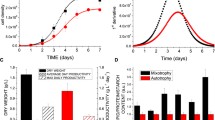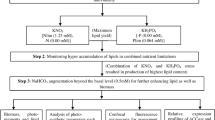Abstract
Nannochloropsis oculata CCMP 525, Dunaliella salina FACHB 435, and Chlorella sorokiniana CCTCC M209220 were compared in mixotrophic and photoautotrophic cultures in terms of growth rate, protein, and lipid content. Growth improved in glucose, and the biomass productivities of N. oculata, D. salina, and C. sorokiniana were found to be 1.4-, 2.2- and 4.2-fold that observed photoautotrophically. However, biomass and lipid production decreased at the highest glucose concentrations. Meanwhile, the content of protein and lipid were significantly augmented for mixotrophic conditions at least for some species. C. sorokiniana was found to be well suited for lipid production based on its high biomass production rate and lipid content reaching 51% during mixotrophy. Expression levels of accD (heteromeric acetyl-CoA carboxylase beta subunit), acc1 (homomeric acetyl-CoA carboxylase), rbcL (ribulose 1, 5-bisphosphate carboxylase/oxygenase large subunit) genes in C. sorokiniana were studied by real-time PCR. Increased expression levels of accD reflect the increased lipid content in stationary phase of mixotrophic growth, but expression of the acc1 gene remains low, suggesting that this gene may not be critical to lipid accumulation. Additionally, reduction of expression of the rbcL gene during mixotrophy indicated that utilization of glucose was found to reduce the role of this gene and photosynthesis.





Similar content being viewed by others
References
Bligh EG, Dyer WJ (1959) A rapid method for total lipid extraction and purification. Can J Biochem Physiol 37:911–917
Bradford MM (1976) A rapid and sensitive method for the quantitation of microgram quantities of protein utilizing the principle of protein-dye binding. Anal Biochem 72:248–254
Chen F (1996) High cell density culture of microalgae in heterotrophic growth. Trends Biotechnol 14:421–426
Chiu SY, Kao CY, Tsai MT, Ong SC, Chen CH, Lin CS (2009) Lipid accumulation and CO2 utilization of Nannochloropsis oculata in response to CO2 aeration. Bioresour Technol 100:833–838
Cronan JE Jr, Waldrop GL (2002) Multi-subunit acetyl-CoA carboxylases. Prog Lipid Res 41:407–435
Fábregas J, Maseda A, Domínguez A, Otero A (2004) The cell composition of Nannochloropsis sp. changes under different irradiances in semicontinuous culture. World J Microb Biotechnol 20:31–35
Garcia MCC, Mirón AS, Sevilla JMF, Grima EM, Camacho FG (2005) Mixotrophic growth of the microalga Phaeodactylum tricornutum: influence of different nitrogen and organic carbon sources on productivity and biomass composition. Process Biochem 40:297–305
Gouveia L, Marques AE, da Silva TL, Reis A (2009) Neochloris oleabundans UTEX #1185: a suitable renewable lipid source for biofuel production. J Ind Microbiol Biotechnol 36:821–826
Griffiths M, Harrison S (2009) Lipid productivity as a key characteristic for choosing algal species for biodiesel production. J Appl Phycol 21:493–507
Harrison PJ, Waters RE, Taylor FJR (1980) A broad spectrum artificial sea water medium for coastal and open ocean phytoplankton. J Phycol 16:28–35
Hsieh CH, Wu WT (2009) Cultivation of microalgae for oil production with a cultivation strategy of urea limitation. Bioresour Technol 100:3921–3926
Hu Q, Sommerfeld M, Jarvis E, Ghirardi M, Posewitz M, Seibert M, Darzins A (2008) Microalgal triacylglycerols as feedstocks for biofuel production: perspectives and advances. Plant J 54:621–639
Iida S, Miyagi A, Aoki S, Ito M, Kadono Y, Kosuge K (2009) Molecular adaptation of rbcL in the heterophyllous aquatic plant Potamogeton. PLoS One 4:e4633
Ip P-F, Wong K-H, Chen F (2004) Enhanced production of astaxanthin by the green microalga Chlorella zofingiensis in mixotrophic culture. Process Biochem 39:1761–1766
Kay RA (1991) Microalgae as food and supplement. Crit Rev Food Sci Nutr 30:555–573
Lang X, Dalai AK, Bakhshi NN, Reaney MJ, Hertz PB (2001) Preparation and characterization of bio-diesels from various bio-oils. Bioresour Technol 80:53–62
Liang Y, Sarkany N, Cui Y (2009) Biomass and lipid productivities of Chlorella vulgaris under autotrophic, heterotrophic and mixotrophic growth conditions. Biotechnol Lett 31:1043–1049
Liu X, Duan S, Li A, Xu N, Cai Z, Hu Z (2009) Effects of organic carbon sources on growth, photosynthesis, and respiration of Phaeodactylum tricornutum. J Appl Phycol 21:239–246
Liu J, Huang J, Sun Z, Zhong Y, Jiang Y, Chen F (2011) Differential lipid and fatty acid profiles of photoautotrophic and heterotrophic Chlorella zofingiensis: assessment of algal oils for biodiesel production. Bioresour Technol 102:106–110
Livak K, Schmittgen T (2001) Analysis of relative gene expression data using real-time quantitative PCR and the \( {{2}^{{ - \Delta \Delta {\text{Ct}}}}} \) method. Methods 25:402–408
Ludwig TG, Goldberg HJV (1956) The anthrone method for the determination of carbohydrates in foods and in oral rinsing. J Dental Res 35:90–94
Marquez F, Sasaki K, kakizono T, Nishio N, Nagai S (1993) Growth characteristics of Spirulina platensis in mixotrophic and heterotrophic cinditions. J Ferment Bioeng 76:408–410
Martinez F, Orus M (1991) Interactions between glucose and inorganic carbon metabolism in Chlorella vulgaris strain UAM101. Plant Physiol 95:1150–1155
Nakkaew A, Chotigeat W, Eksomtramage T, Phongdara A (2008) Cloning and expression of a plastid-encoded subunit, beta-carboxyltransferase gene (accD) and a nuclear-encoded subunit, biotin carboxylase of acetyl-CoA carboxylase from oil palm (Elaeis guineensis Jacq.). Plant Sci 175:497–504
Portis A, Parry M (2007) Discoveries in Rubisco (Ribulose 1,5-bisphosphate carboxylase/oxygenase): a historical perspective. Photosynth Res 94:121–143
Reed MC, Lieb A, Nijhout HF (2010) The biological significance of substrate inhibition: a mechanism with diverse functions. Bioessays 32:422–429
Ren L-J, Huang H, Xiao A-H, Lian M, Jin L-J, Ji X-J (2009) Enhanced docosahexaenoic acid production by reinforcing acetyl-CoA and NADPH supply in Schizochytrium sp. HX-308. Bioproc Biosyst Eng 32:837–843
Richard W, Castenhol Z (1988) Culturing methods for cyanobacteria. Method Enzym 3:68–95
Rosenberg JN, Oyler GA, Wilkinson L, Betenbaugh MJ (2008) A green light for engineered algae: redirecting metabolism to fuel a biotechnology revolution. Curr Opin Biotechnol 19:430–436
Sasaki Y, Nagano Y (2004) Plant acetyl-CoA carboxylase: structure, biosynthesis, regulation, and gene manipulation for plant breeding. Biosci Biotechnol Biochem 68:1175–1184
Spreitzer RJ, Salvucci ME (2002) Rubisco: structure, regulatory interactions, and possibilities for a better enzyme. Annu Rev Plant Biol 53:449–475
Tian J, Yu J (2009) Changes in ultrastructure and responses of antioxidant systems of algae (Dunaliella salina) during acclimation to enhanced ultraviolet-B radiation. J Photochem Photobiol B 97:152–160
Xu F, H-h Hu, Cong W, Z-l C, Ouyang F (2004) Growth characteristics and eicosapentaenoic acid production by Nannochloropsis sp. in mixotrophic conditions. Biotechnol Lett 26:51–53
Yu H, Jia S, Dai Y (2009) Growth characteristics of the cyanobacterium Nostoc flagelliforme in photoautotrophic, mixotrophic and heterotrophic cultivation. J Appl Phycol 21:127–133
Zhang C-W, Zmora O, Kopel R, Richmond A (2001) An industrial-size flat plate glass reactor for mass production of Nannochloropsis sp. (Eustigmatophyceae). Aquac 195:35–49
Acknowledgment
This work was supported by Chinese Natural Science Foundation For Distinguished Group (no. 50621063) and Graduate Innovation Project of Central South University (no. 2010bsxt05).
Author information
Authors and Affiliations
Corresponding author
Additional information
M. Wan and P. Liu contributed equally to this work.
Rights and permissions
About this article
Cite this article
Wan, M., Liu, P., Xia, J. et al. The effect of mixotrophy on microalgal growth, lipid content, and expression levels of three pathway genes in Chlorella sorokiniana . Appl Microbiol Biotechnol 91, 835–844 (2011). https://doi.org/10.1007/s00253-011-3399-8
Received:
Revised:
Accepted:
Published:
Issue Date:
DOI: https://doi.org/10.1007/s00253-011-3399-8




